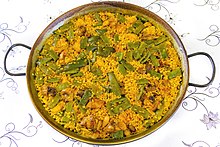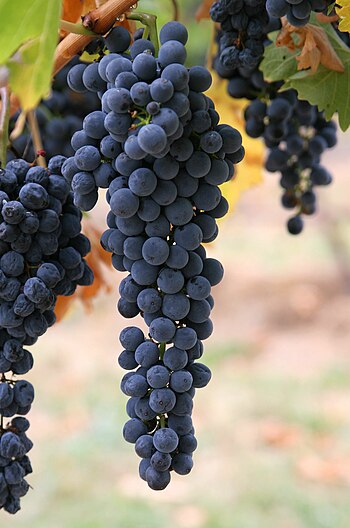
A | B | C | D | E | F | G | H | CH | I | J | K | L | M | N | O | P | Q | R | S | T | U | V | W | X | Y | Z | 0 | 1 | 2 | 3 | 4 | 5 | 6 | 7 | 8 | 9
F o o d
A portal dedicated to food and foodways
Introduction


Food is any substance consumed by an organism for nutritional support. Food is usually of plant, animal, or fungal origin and contains essential nutrients such as carbohydrates, fats, proteins, vitamins, or minerals. The substance is ingested by an organism and assimilated by the organism's cells to provide energy, maintain life, or stimulate growth. Different species of animals have different feeding behaviours that satisfy the needs of their metabolisms and have evolved to fill a specific ecological niche within specific geographical contexts.
Omnivorous humans are highly adaptable and have adapted to obtain food in many different ecosystems. Humans generally use cooking to prepare food for consumption. The majority of the food energy required is supplied by the industrial food industry, which produces food through intensive agriculture and distributes it through complex food processing and food distribution systems. This system of conventional agriculture relies heavily on fossil fuels, which means that the food and agricultural systems are one of the major contributors to climate change, accounting for as much as 37% of total greenhouse gas emissions. (Full article...)
Cooking, also known as cookery or professionally as the culinary arts, is the art, science and craft of using heat to make food more palatable, digestible, nutritious, or safe. Cooking techniques and ingredients vary widely, from grilling food over an open fire, to using electric stoves, to baking in various types of ovens, reflecting local conditions.
Preparing food with heat or fire is an activity unique to humans. Archeological evidence of cooking fires from at least 300,000 years ago exists, but some estimate that humans started cooking up to 2 million years ago.
The expansion of agriculture, commerce, trade, and transportation between civilizations in different regions offered cooks many new ingredients. New inventions and technologies, such as the invention of pottery for holding and boiling of water, expanded cooking techniques. Some modern cooks apply advanced scientific techniques to food preparation to further enhance the flavor of the dish served. (Full article...)

The company has production facilities in Richmond, British Columbia and Hagerstown, Maryland. All of Gardein's products are vegan. The company uses a proprietary process to make its meatless products. In 2014, the company began producing gluten free meatless products. (Full article...)
Selected article –

An orange, also called sweet orange to distinguish it from the bitter orange (Citrus × aurantium), is the fruit of a tree in the family Rutaceae. Botanically, this is the hybrid Citrus × sinensis, between the pomelo (Citrus maxima) and the mandarin orange (Citrus reticulata). The chloroplast genome, and therefore the maternal line, is that of pomelo. The sweet orange has had its full genome sequenced.
The orange originated in a region encompassing Southern China, Northeast India, and Myanmar; the earliest mention of the sweet orange was in Chinese literature in 314 BC. Orange trees are widely grown for their sweet fruit. The fruit of the orange tree can be eaten fresh, or processed for its juice or fragrant peel. In 2022, 76 million tonnes of oranges were grown worldwide, with Brazil producing 22% of the total, followed by India and China. (Full article...)Selected cuisine -

Ancient Israelite cuisine refers to the culinary practices of the Israelites from the Late Bronze Age arrival of Israelites in the Land of Israel through to the mass expulsion of Jews from Roman Judea in the 2nd century CE. Dietary staples among the Israelites were bread, wine, and olive oil; also included were legumes, fruits and vegetables, dairy products, fish, and meat.
Israelite cuisine was adherent to the dietary restrictions and guidelines of Yahwism and its later-developed forms: Judaism and Samaritanism. There was a considerable continuity in the main components of the diet over time, despite the introduction of new foodstuffs at various stages. The food of ancient Israel was similar to that of other Mediterranean cuisines of the time. (Full article...)Selected ingredient –

Anchovies are small, common saltwater forage fish in the family Engraulidae that are used as human food and fish bait. There are 144 species in 17 genera found in the Atlantic, Indian, and Pacific Oceans. Anchovies are usually classified as oily fish. They are small, green fish with blue reflections due to a silver longitudinal stripe that runs from the base of the caudal fin. They range from 2 centimetres (0.79 in) to 40 centimetres (16 in) in adult length, and the body shape is variable, with more slender fish in northern populations.
A traditional method of processing and preserving anchovies is to gut and salt them in brine, allow them to cure, and then pack them in oil or salt. This results in the characteristic strong flavor associated with anchovies, and their flesh turns deep grey. Anchovies pickled in vinegar, as with Spanish boquerones en vinagre, are milder, and the flesh retains a white color. For domestic use, anchovy fillets are sometimes packed in oil or salt in small tins or jars, sometimes rolled around capers. Anchovy paste is also available, as is anchovy essence. Anchovy mash is also sold in the UK under the label of Gentleman's Relish. (Full article...)
Selected recipe –
Paella (/paɪˈɛlə/, /pɑːˈeɪjə/, py-EL-ə, pah-AY-yə, Valencian: [paˈeʎa], Spanish: [paˈeʝa]) is a rice dish originally from the Valencian Community. Paella is regarded as one of the community's identifying symbols. It is one of the best-known dishes in Spanish cuisine.
The dish takes its name from the wide, shallow traditional pan used to cook the dish on an open fire, paella being the word for a frying pan in Valencian language. As a dish, it may have ancient roots, but in its modern form, it is traced back to the mid-19th century, in the rural area around the Albufera lagoon adjacent to the city of Valencia, on the Mediterranean coast of Spain. (Full article...)

George Constant Louis Washington (May 20, 1871 – March 29, 1946) was a Belgian inventor and businessman. He is best remembered for his improvement of an early instant coffee process and for the company he founded to mass-produce it, the G. Washington Coffee Company.
An emigrant from his native Belgium, he arrived in the New York area in 1897. He dabbled in several technical fields before hitting upon manufacturing an adapted version of the nascent instant coffee, during a sojourn in Central America in 1906 or 1907. He began selling his coffee in 1909 and founded a company to manufacture it in 1910. Based in New York and New Jersey, his company prospered and became an important military supplier during World War I. The company's products were also advertised in New York newspapers and on the radio. The success of his company made Washington wealthy, and he lived in a mansion in Brooklyn and then moved to a country estate in New Jersey in 1927. In that same year, he lost a dispute with the tax authorities. Washington was married and had three children. (Full article...)Selected image –
Selected biography –
B. September 13, 1857 – d. October 13, 1945
Milton Snavely Hershey (September 13, 1857 – October 13, 1945) was an American chocolatier, businessman, and philanthropist.
Trained in the confectionery business, Hershey pioneered the manufacture of caramel, using fresh milk. He launched the Lancaster Caramel Company, which achieved bulk exports, and then sold it to start a new company supplying mass-produced milk chocolate, previously a luxury good. (Full article...)
Did you know (auto-generated) –

- ... that before Angeli Foods was sold this year, the first self-service grocery store in the Upper Peninsula of Michigan had been owned by three generations of a single family?
- ... that after George Alexander Albrecht collapsed when conducting Beethoven's Ninth Symphony during a New Year's concert, he returned to composing and began hospice work?
- ... that the Unitized Group Ration – Express is designed to heat food itself without the need of a field kitchen?
- ... that in countries like the United States, prisoners supplement inadequate prison food by combining ingredients like instant ramen, mayonnaise and Kool-Aid into improvised meals called "spreads"?
- ... that the vegan-food brand Squeaky Bean produces food that does not contain beans?
- ... that a New York pop-up restaurant opened by Louisa Shafia served stews and rice dishes described in a review as a "Persian-tapas gateway into the ancient cuisine"?
More did you know –
Related portals
Food topics
The following are topics relating to food

























